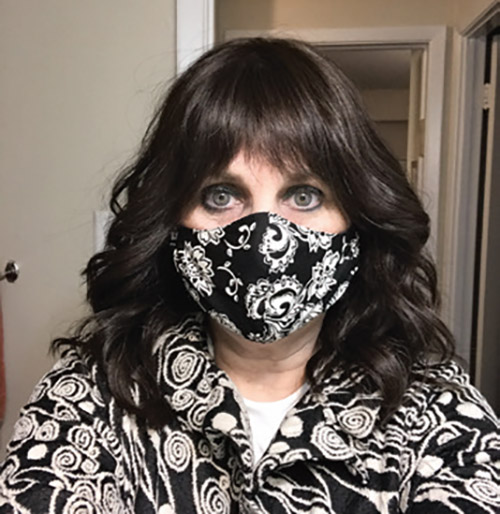


As the country begins to open up, many will be taking their first tentative steps in public in more than a month. Masks are de rigueur. Which type will you wear—strictly utilitarian or more creative? Purchased or home-made?
Beverly Luchfeld of Teaneck has been making elegant Shabbat robes, loungewear and hostess gowns under the name Raza Designs ( www.razadesigns.com ) for 30 years. For the last few months, she has also been making masks for customers and hospitals.
Pesach is usually her busiest season, but this year it was non-existent. She saw the urgent need for masks for hospital workers and thought there was a market there. “My heart went out to my workers,” said Luchfeld. “I didn’t believe they would get unemployment soon. And I didn’t want to lose the contractors, sewers and cutters who I rely on.” She learned, however, that hospitals could only buy N95 masks. She had another thought: She could donate her masks to wear on top of the surgical ones. “I went back to the hospitals and said ‘I’m giving you them for free.’ Then the doors started swinging wide open.”
Luchfeld’s donations are made possible through a combination offer to customers. When someone buys one package of three masks, in solid colors or prints, she donates two packages to medical facilities, constructed according to their guidelines. The hospital masks are pure white cotton with a strong weave so they can be bleached and sanitized, with a pocket to insert a filter. The fashion masks can be washed separately with soap and hot water, in order to maintain their design and color.
Several customers have been sending Luchfeld photos of her masks coordinated with their outfits. A.S., a psychotherapist in private practice in Baltimore, who preferred that her full name not be printed, sent a photo of herself with a black and white print mask that accessorized perfectly with one of her shirts. She told the Jewish Link the backstory. She had taken a socially distanced walk with a close friend, and inquired where she got her mask. The answer was Raza Designs. A.S knew the company—she had bought a Raza Designs Shabbat robe years before—and ordered a few masks for herself. “They are just beautiful,” she said.
Barbara Blumenthal of Englewood is a quilter who always has lots of fabric on hand. She got an email from one of her quilting groups with a link to patterns for making masks. “I’ve made about 75 so far,” she said. “I am making them for friends and elderly family members and their caregivers.” Blumenthal said the process is pretty labor intensive. “There are a lot of steps—wash, iron, cut, fold, form. There are so many different patterns. I just wanted to get them made and not obsess about the design.” She had some difficulty getting supplies. There was a shortage of plastic cord needed for the loops to go around the ears. She ordered some that never showed up and finally bought rubber bands from Staples. Unhappy with the result, she later switched to shoe laces!
Blumenthal uses two layers of pre-washed, 100% cotton. For friends on the front lines, she adds a layer of flannel, which is easier than putting in a pocket for a filter. She cautioned anyone making or purchasing masks that a mask with flannel is too thick to be used during aerobic activity like jogging.
Blumenthal is taking a temporary break from making masks; she only has plain fabric and some left over from Pesach projects. “I don’t know if anyone wants a mask with frogs, wild animals or hail,” she quipped.
The internet is overflowing with ads to purchase masks of all sorts, from plain paper to the wildest prints, and there are many sources with directions for making them yourself. There are even directions on the Centers for Disease Control and Prevention (CDC) website that call for only fabric, a pair of scissors and two rubber bands.
There is universal acknowledgement that only N95 masks can keep most virus particles from reaching the wearer. But any mask offers some protection and may prevent you from infecting others. And masks keep you from touching your face.
In an April 22 op-ed, New York Times fashion director Vanessa Friedman posed the question: “Should Masks Be a Fashion Statement?” She wrote that the plain mask represents the shared vulnerability we all have. And she thinks it’s possible that designers will take advantage of our fear to excessively price their products.
Yet one style of mask does not negate the other. Make your own. Buy from any number of vendors. No one is locked into one path. And as A.S. said about the mask she purchased from Raza Designs, “If you have to wear a mask, you might as well wear one that’s gorgeous.”










